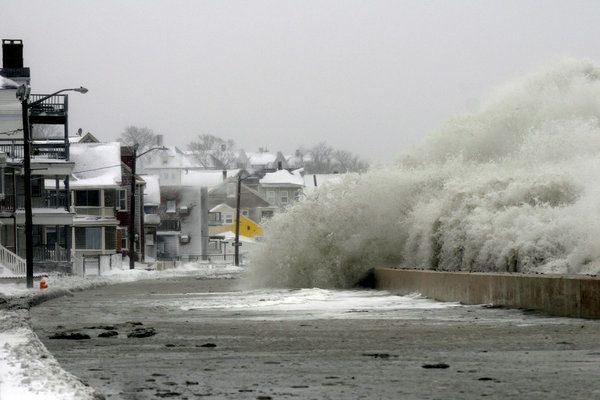Memo to Gov. Christie: Sea Walls and Engineering Don’t Work
Our Friends in Massachusetts Know That
Engineering, Sea Walls, Structural Solutions “Only as a Last resort”
[*update below]
I just saw the above dramatic photo in today’s New York Times’ article on Nemo, which stoked my curiosity and prompted a brief inquiry into how our friends in Massachusetts manage their highly vulnerable coast.
I can’t resist publishing my findings.
The Massachusetts folks are far more enlightened than our Rebuild Madness (TM) Governor, who continues to mislead the public about engineered solutions to coastal hazards and to deny increasing climate change vulnerabilities.
Just like NJ’s coastal experts (with the exception of a few hacks, who get all the newspaper quotes), here’s what state officials in Massachusetts’ Office of Coastal Zone Management say about sea walls and engineered “structural solutions” –
(so this is set out especially for you Gov. Christie and DEP Commissioner Martin):
ONLY AS A LAST RESORT: Flood and Erosion Control Structures
In the past, protecting coastal shorelines often meant structural projects like seawalls, groins, rip-rap, and levees. As understanding of natural shoreline function improves, there is a growing acceptance that structural solutions frequently cause more problems than they solve, and they are often not allowed under the Massachusetts Wetlands Protection Act. Structural protective measures often:
- Are expensive.
- Are not permissible under local and state regulations.
- Cause erosion to beaches and dunes, leading to a loss of recreational and tourism resources and diminished storm damage protection.
- Aren’t permanent, in fact require costly maintenance to ensure that they continue to provide protection.
- Divert stormwater and waves onto other properties.
- Adversely affect other properties by starving beaches of needed sediment sources.
- Create a false sense of security.
- Disturb the land and disrupt natural water flows.
Structural protection should only be considered as a last resort, knowing that it will be an ongoing expense and may increase overall damage to land, buildings, and other structures within the natural system. Whenever structural protection is pursued, hybrid technology (such as combinations of low-profile rock, cobble berms, and vegetative planting, or combinations of marsh plantings and coconut fiber rolls) should be considered as a means of reducing the negative impacts of the structure.
The Massachusetts media covers this issue, see: Sea walls may do more harm than good
So why does our Governor continue to mislead on this issue? How does he get away with this?
Why is DEP Commissioner Martin so clueless? He has coastal experts on staff in DEP’s Office of Coastal Zone Management who can tell him this.
[* But Martin is listening only to DEP’s Office of Coastal Engineering, a group that, like Martin, is in deep denial about climate change, sea level rise, natural coastal processes, and fails to comprehend the need for regional planning and the unsustainable costs of pumping sand.]
Why does the NJ Press corps not report this science?
* The New York Times correctly framed the issue – just days after the storm, the Times wrote this: Costs of Shoring Up Coastal Communities –
This is a debate Gov. Christie has been allowed to distort and evade – with no pushback from a cheerleading “rebuild now!” NJ press corps (with the exception of WNYC) and a compromised environmental community (except for Sierra Club) that has other priorities and is supportive of or unwilling to alienate the Governor:
But even as these towns clamor for sand, scientists are warning that rising seas will make maintaining artificial beaches prohibitively expensive or simply impossible. Even some advocates of artificial beach nourishment now urge new approaches to the issue, especially in New Jersey.
The practice has long been controversial.
Opponents of beach nourishment argue that undeveloped beaches deal well with storms. Their sands shift; barrier islands may even migrate toward the mainland. But the beach itself survives, because buildings and roads do not pin it down.
By contrast, replenishment projects often wash away far sooner than expected. The critics say the best answer to coastal storms is to move people and buildings away from the water, a tactic some call strategic retreat. […]
But as the climate warms, sea levels are rising and bad storms may come more frequently. And New Jersey is particularly vulnerable because of tectonic forces and changes in ocean currents.
When the glaciers retreated about 15,000 years ago, land in the region bounced up; now it is sinking again. Meanwhile, ocean circulation patterns are changing in ways that push water up against the mid-Atlantic coast.
“We cannot sustain the shoreline in the future as we have in the past,” said Mr. Williams, of the Geological Survey. “Particularly from a beach nourishment standpoint.”
